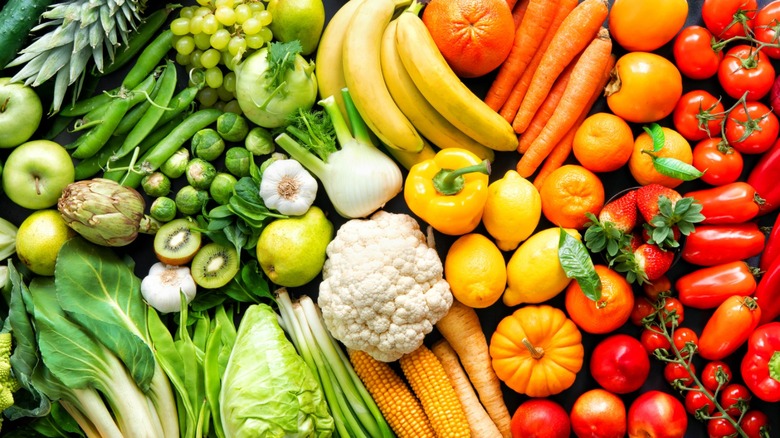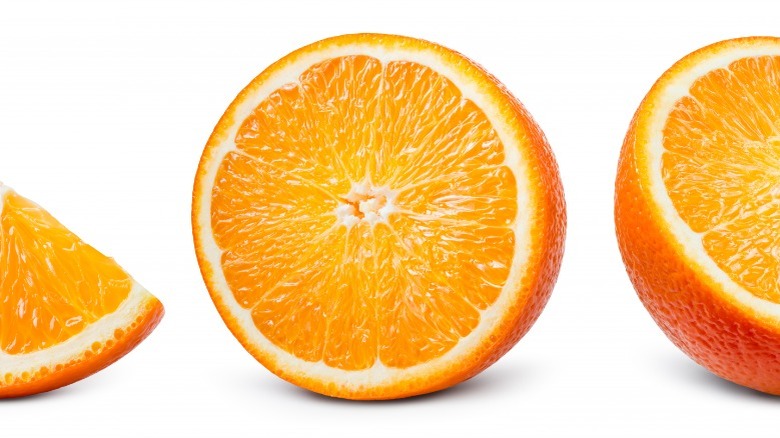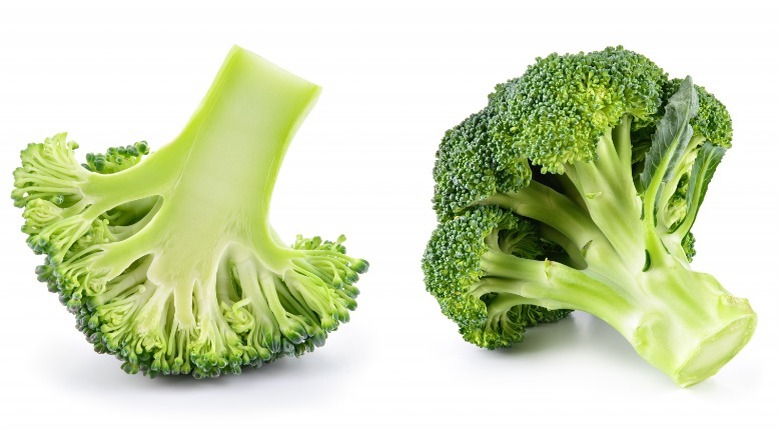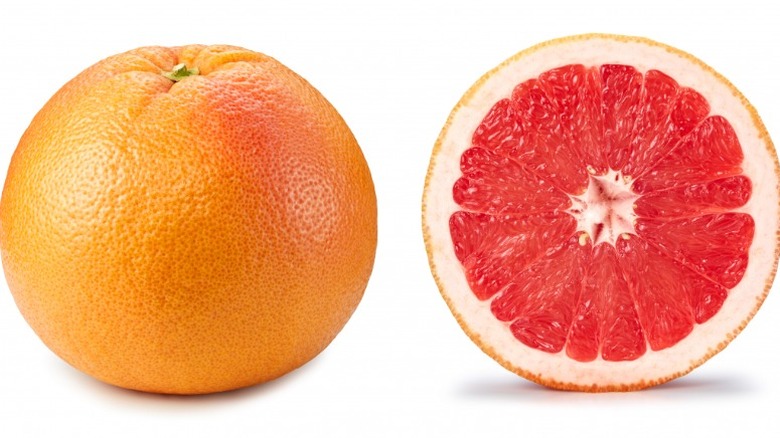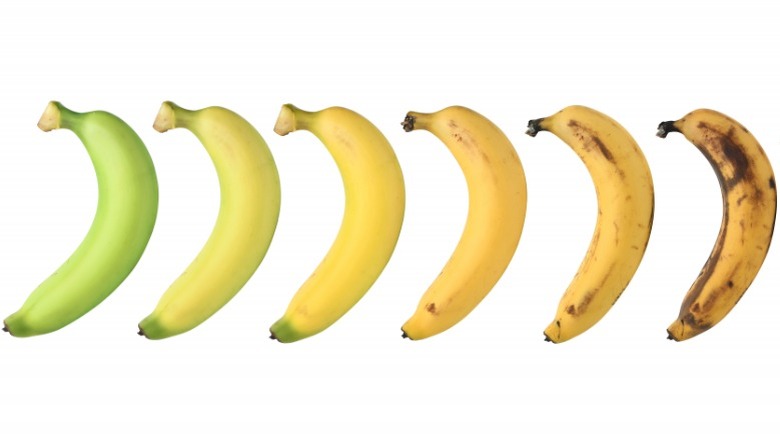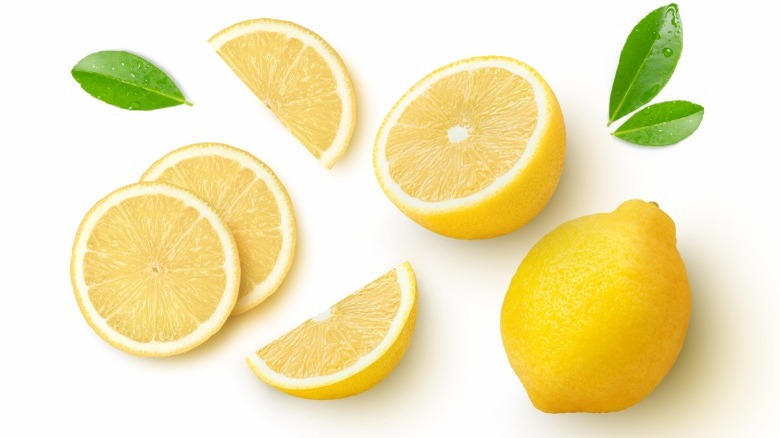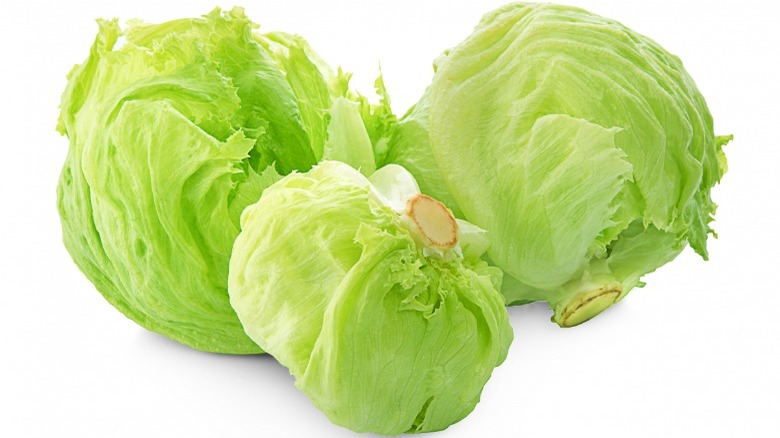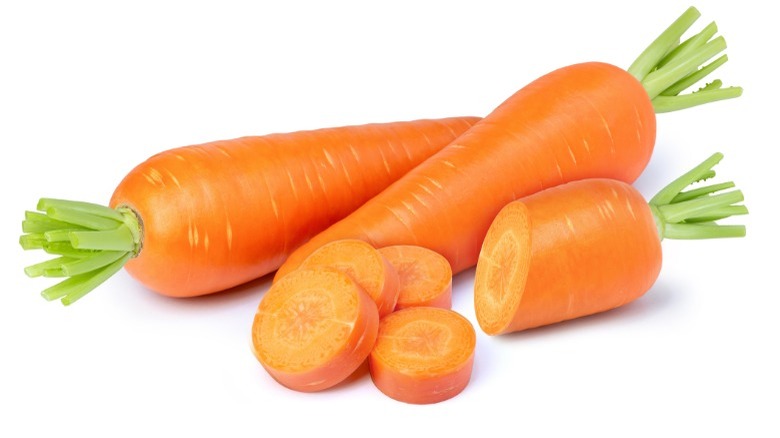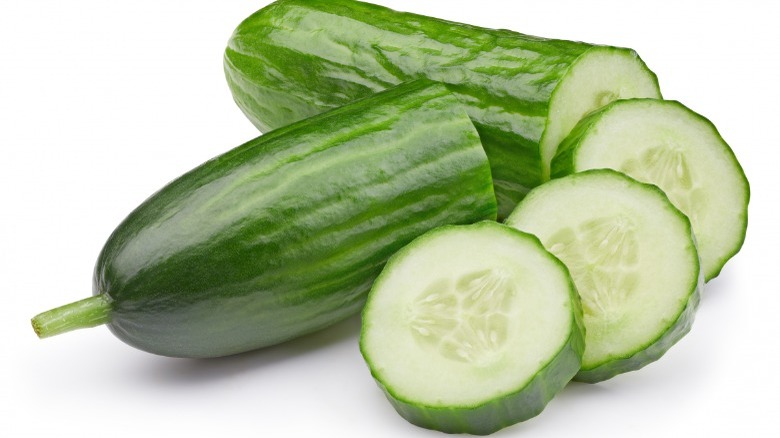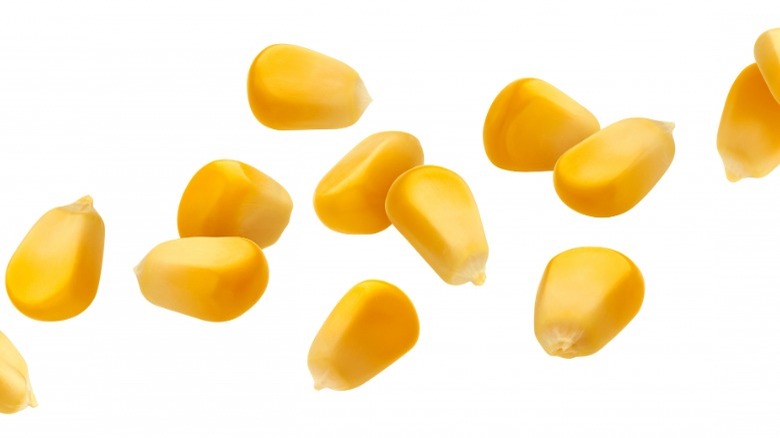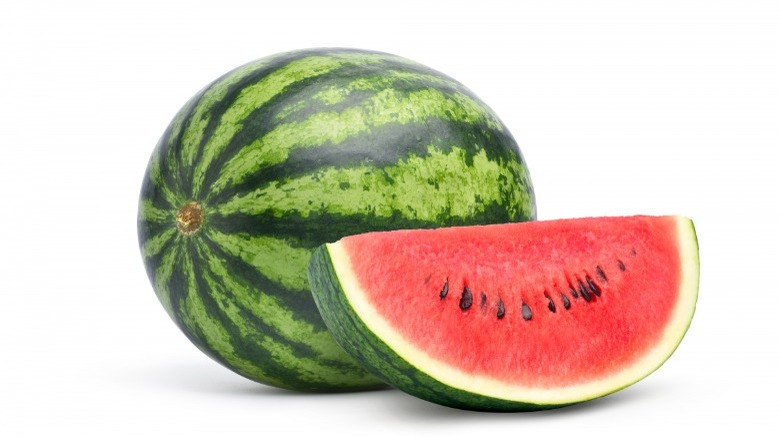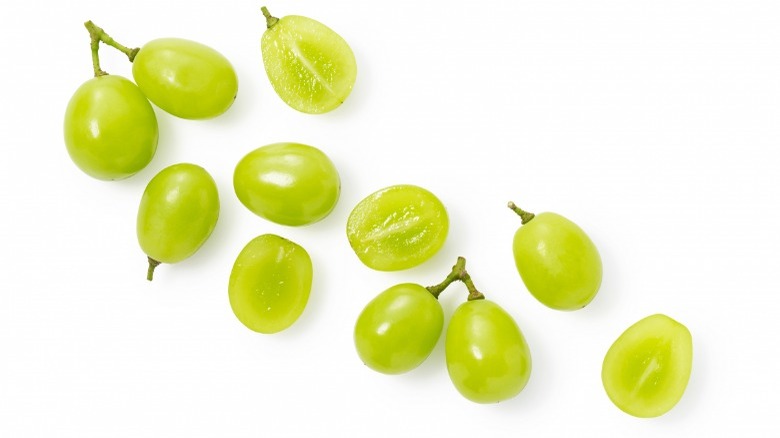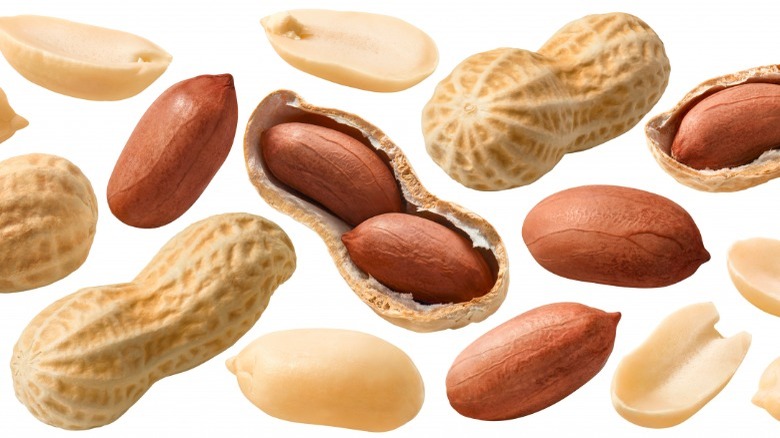13 Types Of Produce You Didn't Know Were Man-Made
When you bite into a juicy watermelon slice or munch on a handful of seedless grapes, it's easy to assume that these fruits have always existed in their current form. But the truth is that many of our favorite fruits and vegetables have been selectively bred, hybridized, and genetically modified by humans over thousands of years. From the earliest days of agriculture to modern genetic engineering techniques, people have been tinkering with plants to make them tastier, sturdier, and easier to grow.
Get ready to explore the fascinating history of some of the most common produce items and uncover the surprising ways that humans have shaped their evolution. We'll learn how wild citrus fruits were transformed into the oranges, lemons, and grapefruit we know today and how an ancient grass was domesticated and bred into hundreds of different varieties of corn. We'll also discover the origin stories of bananas, cucumbers, and iceberg lettuce, and take a closer look at how a combination of pure chance, nature's mysterious mutations, and human ingenuity over time have given rise to some truly unique edible plants. So whether you're a fan of heirloom tomatoes or seedless watermelon, this exploration of the man-made produce we encounter on a regular basis will surely shine some light on the origin stories of your favorite fruits and veggies.
Oranges
These ubiquitous citrus fruits have been around for so long it's hard to imagine humanity without them. Despite the fact that they've been around for millennia, today's sweet oranges didn't actually exist in nature and had to be brought into existence by humans. The origin of oranges is often attributed to ancient China, where their first written mention, dated 314 B.C., was discovered. Later, they were introduced to Europe by the Moors during their rule in Spain in the 8th century and brought to the Americas by Spanish explorers in the 15th century.
The wild orange was bitter and sour (and is still known under these names), so it wasn't involved in developing the new, sweet species. Instead, they cross-pollinated pomelo and mandarin. One is a large, yellow, thick-skinned, sweet citrus, and the other is a smaller, orange-colored bitter fruit. Both are believed to be original non-hybrid citrus species that became the ancestors of all subsequent citrus fruits. Over time, various types of oranges were developed through cross-breeding and selection. Today, the ever-growing orange family tree has hundreds of varieties, including peculiarly shaped sweet and acidic Sumo oranges and seedless Cara Cara oranges that pack a sweet punch.
Broccoli
This nutritious plant was enjoyed in Italy long before it became a mainstay anywhere else. Apicius, the famous ancient Roman recipe collection, and writings of Pliny the Elder both mention a vegetable fitting broccoli's description. But it's not like they accidentally found it in the wild. In fact, broccoli is a man-made descendant of the wild mustard plant, Brassica oleracea. Its ancestors were bitter and had small, undeveloped heads, and it took many generations of cross-breeding and selection to create the larger, more tender heads we know and love today. Thus, America's favorite vegetable (and its various cousins such as cauliflower, Brussels sprouts, and kale, all coming from Brassica oleracea) wouldn't exist if it wasn't for the agricultural efforts of ancient Etruscans.
But the story of broccoli doesn't end there. In recent years, a new hybrid of broccoli has emerged called broccolini, a cross between broccoli and Chinese kale, or gai lan. The difference between broccolini and its namesake parent plant is both in appearance and taste. The former owes its long, tender stalks, small, delicate florets, and a sweeter, more delicate flavor to gai lan. Another modern-day broccoli hybrid is broccoflower — a chartreuse cross between broccoli and cauliflower that is sometimes confused with romanesco.
Tomatoes
Present-day tomatoes have come a long way from their humble natural origins to their current status as one of the most beloved fruits in the world. Previously, it was believed that about 7,000 years ago, the people in South America domesticated Solanum pimpinellifolium —a wild tomato plant with tiny fruit — until it reached the size of a cherry, and that modern tomatoes are a direct descendant of this intermediate semi-domesticated breed. However, a 2020 study revealed that it existed in the area as far back as 80,000 years, which predates human crop cultivation. It is still unclear how this nightshade family member was able to travel northward to Mesoamerica, but once humans got to work on it, it started to take its modern shape.
It wasn't until the 16th century that tomatoes were introduced to Europe, and even then, they were slow to catch on. In fact, for many years, tomatoes were considered ornamental rather than edible. It wasn't until the 19th century that tomatoes began to be bred specifically for their culinary value, with larger, juicier varieties being developed through cross-breeding and selection. Today, there are hundreds of different tomato varieties, ranging from small cherry tomatoes to large beefsteak tomatoes. And with new varieties and uses still being developed, it's clear that the tomato's journey is far from over.
Grapefruits
Compared to lemons and oranges, these thick-skinned fruits are a relatively recent addition to the citrus family, having been first discovered in the Caribbean around 300 years ago. Moreover, grapefruits are actually a hybrid of two other citrus fruits — pomelo and sweet orange (the latter itself being a hybrid of pomelo and mandarin). It is believed that grapefruits were first created by chance due to the Europeans' casual planting of citrus trees around the West Indies. Citrus trees are naturally prone to hybridization, so when pomelos and sweet oranges were planted next to each other, and their seeds crossed, it resulted in a new fruit.
The first recorded mention of grapefruit was in Jamaica in the early 18th century, where it was referred to as the "forbidden fruit." But it wasn't until Count Odette Philippe cultivated the fruit in Florida and established the first post-colonial commercial grove in the 1820s that they gained commercial importance. Once a delicacy of the rich, grapefruits were cultivated and bred over time for their sweeter, less bitter flavor. Today there are many different varieties of grapefruit available, from pink and red to white and yellow.
Bananas
While there are hundreds of types of bananas, all different in size, color, texture, and flavor, they all have evolved from their wild ancestors under human domestication. The bananas we know today are descendants of two wild progenitor species — Musa acuminata, which had a meaty but unappealing flesh, and Musa balbisiana, which had too many seeds for it to be enjoyable, per Plant Gene. While the sweet, seedless, yellow banana is believed to have appeared from random mutation, without human intervention, it wouldn't have transformed from a wild foodstuff into a staple. Moreover, the modern banana can't reproduce without human help because its appealing lack of seeds directly results from cloning.
Unfortunately, that's exactly why the banana you're likely familiar with could become extinct. The Cavendish banana, which is currently the most widely grown banana variety in the world, is threatened by a new strain of the same fungal disease that wiped out the Gros Michel banana (the Cavendish of the early 20th century). And because most Cavendish bananas are genetically identical clones, there is a high risk of the disease spreading rapidly and decimating banana crops worldwide. Therefore, it's possible that we could see a shift towards other banana cultivars that are more resistant to disease or even some new hybrid varieties. But for now, let's savor and appreciate the humble Cavendish banana while we still can.
Lemons
Life didn't necessarily give humans lemons, so they had to make lemons themselves — or at least build upon the natural hybridization of protogenic citrus plants. Today, lemons are a staple around the world, but their origin story is a bit of a mystery. While it is believed that lemons are a mix of two other citrus fruits — the citron and the bitter orange — there is some debate over whether lemons are a man-made fruit or if they occur naturally.
Citrons, naturally, are quite different from lemons — they are large, thick-skinned citrus fruits that are native to Southeast Asia and considered to be one of nature's original citrus fruits. In contrast, bitter oranges are a hybrid of pomelo and mandarins, known for their tart, bitter flavor. It is believed that lemons were first created by chance when citrons and bitter oranges were planted next to each other and their seeds crossed, resulting in a new hybrid fruit.
And then there are Meyer lemons, which are a slightly different story. Meyer lemons are believed to be a hybrid of lemon and mandarin or sweet orange, which is why they aren't considered true lemons. They originated and China and were treated as decorative plants, but Frank Meyer, a United States Department of Agriculture worker, brought them back to the U.S. in the early 20th century, where they are still celebrated for their unique floral and sweet flavor.
Iceberg lettuce
One of America's most consumed green vegetables with the most scandalous reputation wouldn't exist if it wasn't for Atlee Burpee & Co., an American mail-order seed company. Founded in the late 19th century, the company focused on developing new vegetable varieties better suited to commercial farming and shipping. In 1894, its founder, W. Atlee Burpee, introduced a revolutionary lettuce variety that was able to maintain its fresh crispness longer than other greens. But what gave it its name and helped it spread across the country, introducing salads to homes and restaurants, has everything to do with its transportation.
A farmer named Bruce Church played a significant role in popularizing lettuce, particularly iceberg lettuce, in the United States. Church's early success in the lettuce industry came from his idea to pack and ship lettuce in ice, which he did with a field of head lettuce in 1926 to great commercial success. According to one company legend, the term "iceberg lettuce" originated from the excitement of children in Maine, who would exclaim that "The icebergs are coming!" when the lettuce shipments arrived. Today, iceberg lettuce remains a staple of American cuisine, and its popularity is due in no small part to the efforts of people like W. Atlee Burpee and Bruce Church.
Orange carrots
Prior to the domestication of its edible root, carrots were cultivated for their leaves and seeds, which were used in medicine. The root of the plant was thin, woody, and bitter, unlike the plump, sweet carrots we know today. Over time, selective breeding by farmers in Europe and Asia resulted in the development of larger, more palatable roots. But the carrots of the Middle Ages were largely white, yellow, and purple and had a sweet rival by the name of parsnip.
That changed when the 17th-century Dutch farmers began cultivating orange carrots. Although orange carrots existed naturally, it was the Dutch who turned them into a mainstay. The orange carrot quickly gained popularity in Europe and eventually became the standard variety. In the 19th century, French breeders developed the modern "Nantes" variety, named after the city that had ideal growing conditions for these cylindrical-shaped, smooth-skinned, and sweet carrots. This variety became the basis for most modern carrot breeding programs.
Ironically, today, the old-fashioned heirloom purple, white, and yellow carrot varieties are back in fashion, prized for their unique look and flavor, as well as their nutritional content. Despite their differences, all modern carrots share a common ancestor in the wild carrot, which still grows throughout Europe and Asia.
Cucumbers
If you've ever bitten into a fresh, crunchy cucumber only to be forced to do a spit take right away, you might get the idea of what the original wild cucumbers tasted like before domestication and selective breeding. The cucumbers that humans encountered thousands of years ago had a high concentration of a bitter-tasting, toxic compound called cucurbitacin, which made them dangerous to consume. Over time, cucumbers were bred to minimize bitterness and toxicity. However, by the time ancient Greeks and Romans got their hands on them, they were still too bitter to consume without cooking.
As cultivation progressed, more kinds of palatable cucumbers appeared. Victorian-era households could partake in various cultivars, including large slicing cucumbers, thin-skinned straight cucumbers, and burpless varieties. They might have even partaken in a variety that's often mistaken for a tiny watermelon: cucamelon. Despite its name, it is not a cross between a cucumber and a watermelon but rather a member of the cucumber family that bears a visual resemblance to the striped green fruit. The cucamelon is native to Mexico and Central America, where it has been cultivated for centuries. One other unusual cucumber variety is the lemon cucumber, which appeared in the late 1800s as a result of natural selection. Despite the visual resemblance to its namesake citrus fruit, it is also a true cucumber.
Corn
Corn, also known as maize, is a major food staple around the world, but it was originally a wild grass called teosinte, which doesn't resemble present-day corn visually or nutritionally but has much of the same DNA. The transformation from teosinte barely edible cobs to modern corn took place over thousands of years through the process of domestication and selective breeding by indigenous peoples in Mesoamerica.
Teosinte is a much smaller plant with small ears that contain only a few kernels. Over time, indigenous farmers selectively bred teosinte plants with desirable traits, such as larger ears and more kernels, resulting in the development of what we now know as corn. Recent findings also show that the grain spread around South America before its domestication in the home region was complete. This means that even though modern corn varieties share a common ancestor in teosinte, its evolution path was more dispersed than previously believed.
Today, there are countless varieties of corn — some are used primarily for food, while others are used for animal feed, ethanol production, or industrial purposes. One example of an unusual hybrid variety is glass gem corn, which has translucent kernels that resemble brightly colored glass beads. Another interesting variety is Black Aztec, which is a dark purple-black color and is often used in traditional Mexican dishes.
Watermelons
The ancient truth about the origins of watermelons is that the fruit we know today is far from the original. Wild watermelons were about two inches big, bitter, packed with hard seeds, and lacking lycopene — the compound responsible for the red flesh tint of modern fruit. Over thousands of years, humans cultivated watermelons to become larger, sweeter, and with fewer seeds. Ancient Egyptians and other civilizations in the Middle East and Mediterranean region are believed to have been some of the first to cultivate watermelons for their sweet, juicy flesh. In the 17th century, watermelons were brought to America and continued to be selectively bred for desirable traits.
Today, there are countless varieties of watermelons available around the world, ranging from small, seedless, mini watermelons to large, oblong-shaped watermelons with dark green rinds and bright red flesh. Most varieties are reasonably priced when in season; however, the rarest watermelon could cost you thousands of dollars. The Densuke watermelon, grown only on the island of Hokkaido, Japan, has a hard black rind and sweet, crisp flesh. Because only a limited number are grown each year, with strict quality control measures in place, Densuke watermelons can fetch prices upwards of $6,000 at auction. But for most of us, a juicy slice of any watermelon on a hot day is already priceless.
Seedless grapes
While grapes have been a part of the human diet for many centuries, seedless grapes are a relatively new invention. The wild origins of seedless grapes are not well-documented, and it is believed that they were initially developed through natural mutations. However, in the late 19th century, horticulturists in California began experimenting with breeding seedless grapes by crossing different cultivars. The goal was to produce grapes that were larger, sweeter, and easier to eat than their wild counterparts. The first commercially successful seedless grape was the Thompson Seedless grape, which was introduced in the early 20th century. This grape was a hybrid of two different grape varieties and was initially called the Sultana grape. It was renamed the Thompson Seedless grape after William Thompson, a viticulturist who played a significant role in its development and promotion.
Today, there are many different types of seedless grapes available, each with its own unique flavor and characteristics. A recent addition to the family, cotton candy grapes, whose flavor lives up to their name, were an instant hit after being introduced in 2011. Other popular seedless grape varieties include the Flame Seedless, the Crimson Seedless, and the Red Globe. And if you have ever wondered why seedless grapes sometimes have seeds, that's because all grapes do. The seeds in the "seedless" varieties are just small, soft, and underdeveloped, which makes them barely noticeable.
Peanuts
Peanuts, also known as groundnuts, originated in South America and were initially consumed by indigenous populations. Wild peanuts are small, have a hard outer shell, and can be bitter to taste. According to a study in the Journal of Advanced Research, macrofossils show peanuts existed in Peru at least 8,500 years ago and likely evolved began developing 1,500 years before that. Modern research shows that human-bred peanuts have double the number of chromosomes compared to most other species in their genus. Despite their debated origins, a 2014 article states they are believed to have come about through a single hybridization event between two wild diploid species: Arachis duranensis and Arachis ipaensis. This resulted in an allotetraploid, or a species with four sets of chromosomes, half resembling the form of one wild species and half resembling another. The wild allotetraploid then underwent domestication and improvement to become the cultivated peanut we know today.
The cultivation of peanuts spread northward from South America, eventually reaching North America in the 1700s. Peanuts quickly became popular in the United States, where they were used to feed both humans and livestock. They became so big that two different U.S. presidents dabbled in peanut farming, and the creamy paste made from them became synonymous with American food. Today, these versatile legumes are an important crop worldwide, with most of the world's peanuts coming from China.
